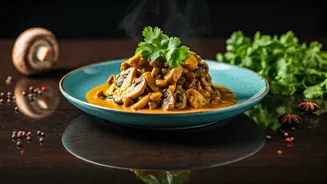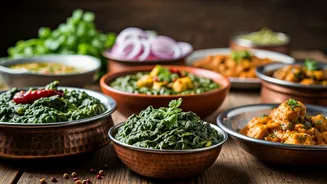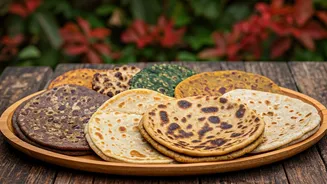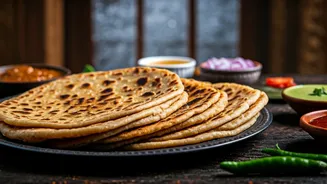Introduction to Curries
Curries, renowned for their delightful medley of spices and rich flavors, represent a significant part of India's culinary heritage. The versatility of curries
allows for the utilization of diverse ingredients, with mushrooms being a noteworthy element. Mushrooms, particularly those exposed to sunlight, are a valuable source of vitamin D, which is essential for overall health, especially during the winter when sunlight exposure may be limited. These curries are not only delicious but also offer a healthy way to add flavor and nutrition to your diet.
Mushroom Curry Delights
This article's selection of mushroom curries caters to varied tastes, featuring a spectrum from mild to intensely spiced dishes. One popular choice is a creamy, coconut milk-based curry, known for its mild flavor profile that balances the earthy tones of mushrooms. Another recipe highlights the robust flavors of a tomato-based curry, which is a common choice and offers a tangy and spicy dimension. Beyond these, the article explores curries that integrate local Indian spices, such as garam masala and turmeric. These recipes are presented with straightforward instructions, ensuring accessibility for both seasoned cooks and beginners.
Vitamin D Boosters
The main benefit of these mushroom curries is their vitamin D content, a vital nutrient often deficient during winter. Mushrooms that have been exposed to UV light naturally produce vitamin D. The article highlights how incorporating these curries into your diet is a flavorful strategy to bolster your vitamin D intake. It is important to remember that mushrooms can be a surprisingly good source of vitamin D. The article ensures that these recipes not only please the palate, but also support health by providing essential nutrients. The choice of mushrooms and preparation method is key.
Recipe 1: Creamy Coconut
The first recipe featured is a creamy coconut mushroom curry. This recipe begins by sautéing onions, garlic, and ginger until fragrant, setting the foundation for the curry's depth of flavor. Mushrooms, along with the other spices, such as turmeric and coriander, are introduced. Then, coconut milk is gently stirred in to give the curry its creamy texture. The curry is simmered until the mushrooms are tender and the flavors merge seamlessly. This curry provides a blend of flavors, making it a great option for those new to Indian cuisine or seeking a milder spice level.
Recipe 2: Tomato Based
Next, the tomato-based mushroom curry is presented. This recipe highlights a spicy and tangy flavor profile. Sautéed onions, ginger, and garlic again set the base, with fresh tomatoes then added to the pan to simmer until softened. Spices such as chili powder and garam masala infuse the dish. Mushrooms are added, and the ingredients are cooked until the sauce thickens and the mushrooms absorb the vibrant flavors. This curry is known for its intense flavors and is a popular choice for those wanting to try something a bit spicier.
Recipe 3: Spiced Variety
The third recipe provides a more complex array of spices. The recipe begins similarly, with a base of sautéed aromatics. Spices such as cumin, coriander, and garam masala are introduced to enhance the aroma. Mushrooms are incorporated, with a small amount of water or vegetable broth added to the pan. This allows the mushrooms to cook in their flavors and spices. The article emphasizes how the mix of spices can transform the humble mushroom into an amazing dish, which enhances the overall richness. The level of spice and the variety of spices make this a favorite for those seeking an authentic culinary journey.
Recipe 4: Variations
This section opens up the door to many variations. These include adding different vegetables to the mushroom curry for added flavor and texture. This also includes the use of various mushroom types. The article suggests swapping the mushrooms with others like shiitake or cremini mushrooms, which could alter the taste profile. The section also highlights how one can modify the spice levels to suit individual tastes, which means adding more or less chili, garam masala, or other spices. This recipe allows for a lot of room for creativity in the kitchen.
Recipe 5: Tips & Tricks
This section focuses on essential tips to guarantee success when preparing mushroom curries. It recommends that mushrooms are not overcooked so they retain their texture. The article provides information on how to select fresh mushrooms and what to look for, as well as storage techniques to keep them in top condition. Further tips include the use of fresh herbs, like cilantro or parsley, to garnish the dishes. This step enhances the presentation and brings forth a burst of fresh flavors. Following these suggestions ensures that the curries have optimal flavor and presentation.
Recipe 6: Serving Suggestions
The last section provides ideas for serving mushroom curries. Rice, particularly basmati rice, is the ideal accompaniment, allowing the curry sauce to be savored. The article suggests serving the curry with naan bread, which is perfect for soaking up the delicious gravy. The article also recommends adding raita, a cooling yogurt-based side dish, to balance the spice levels of the curry. Whether it's a simple weeknight dinner or a special occasion, these suggestions turn the curries into complete meals.













